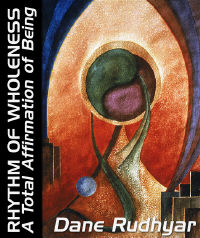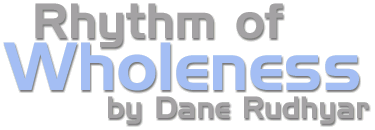 |
| Home | Bio | Art | Music | Literature | Civilization & Culture | Philosophy of Wholeness | Theosophy & Spirituality | Astrology |

RHYTHM OF WHOLENESS A Total Affirmation of Being by Dane Rudhyar, 1983 CONTENTS PROLOGUE PART ONE The Philosophy of Operative Wholeness 1. Prelude to a New Interpretation of Reality 2. The Search for Spiritual Security: The One, the Whole, and Wholeness 3. The Movement of Wholeness PART TWO The Cycle of Being 4. The Structure of the Cycle of Being 5. The Four Crucial Phases of the Cycle of Being 6. The Inevitability of Success and Failure 7. Spirit and Mind PART THREE The Cycle of Man 8. Constitution of Man - The Physical and Psychic Bodies 9. Constitution of Man - The Spiritual Entity and the Higher Mind 10. The Structure and Transformation of the Total Person 11. The Cyclic Process of Spiritual Embodiment PART FOUR In The Spirit of Wholeness 12. The Principle of Holarchy and the Interplay of Horizontal and Vertical Relationships 13. Transpersonal Activity versus Mediumship Page 1 Page 2 Page 3 Page 4 14. Rites of Passage EPILOGUE |

CHAPTER THIRTEEN
Transpersonal Activity versus Mediumship - 3 Who is the "self" in "self-expression"? It is difficult to define the nature of both the creative process (in terms of cultural products) and the "spiritual" transfer of knowledge, healing energies, or transformative power able to produce basic changes in consciousness and the quality of the will. This is largely due to the fundamental ambiguity inherent in the word self. What does the prefix self refer to in the word self-expression? What does the word form mean in any process inducing transformation? Most students of Oriental philosophy, theosophy, mysticism, or even of today's popular psychology and "metaphysics" believe in the existence of a "higher" and a "lower" self. Some psychologists and philosophers nevertheless point out the incongruity of a person having two selves; for the term self implies identity or individuality, the latter literally meaning not-divided or indivisible and refers to the exclusivistic feeling of being "I" and no one else. Philosophically, the problem posed by the concept of two selves results from confusing the inner feeling-realization of wholeness with the nature and quality of the contents of the realizing whole. These contents may originate from two different sources and also may be interpreted in relation to two different frames of reference; yet this does not mean that one can legitimately speak of two "selves." The word self should have no plural, no more than one should speak of two "wholenesses." A human being is a whole, the contents of which (energies, impulses and unself-conscious realizations) initially belong to the level of "life." These contents are progressively modified and partially transformed; they are also interpreted in terms of a new frame of reference — the level at which cultures and societies operate. Only when the societal stage of evolution is reached do philosophers and psychologists usually begin to speak of "self." Culture-man is said to be "self-conscious," a term which often is defined as "conscious of being conscious" or objectively conscious (implying a separation between subject and object). Still, a large portion of the contents of self-conscious personhood (in either a primitive tribe or a complex modern society) remains the product of biological functions and drives and continues to be influenced by health and disease, vitality or weakness. Another portion of the contents of personality nevertheless results from the interpersonal relationships and functional (or dysfunctional) activities of a social community. A sociocultural frame of reference tends to be at least partially substituted for the basic pattern of biological drives, including the will to survival. In some cases of extreme religious asceticism or patriotic fervor, the sociocultural frame of reference may even overpower the biological drives. The experience of selfhood — that is, the centralizing feeling-realization of being "I" — and the quality of the human being's actions and "radiations" change with alterations of the balance of forces in his or her personhood and the nature of the contents of personhood. The consciousness and will may be divided from time to time, driven now by the power of life, then by culture and religion. Nevertheless, one should not speak of a biological self and a cultural self. Self remains self until the human whole fragments at death.(2) However, the totality of a human being includes not only a biological organism and a self-conscious, culturally, and mentally developed personality but also a higher trinity of archetypal and spiritual factors. From the holarchic point of view, "self" refers to all these factors, and more specifically to a power eventually able to integrate the whole combination of constituents in body, personhood, and spiritual entity. This integrative power is the "highest" principle of the spiritual trinity, and it is a power that penetrates all there is, including the body. As a conscious ego, a human being is not aware of this all-pervasive power, any more than inhabitants of the earth are aware of existing within the solar system, indeed within galactic space. Similarly, the atoms and cells of our physical body probably are not aware of operating within a higher (because more inclusive) field of organic activity and self-consciousness (a human body and psyche). Nevertheless, all self-conscious persons operate within a higher field of spiritual selfhood, although the present stage of human evolution precludes an awareness of it; the physical and mental instrumentalities required for conscious perception of this field are still (normally) under-developed.(3) Nevertheless they exist in a latent condition, and the experience of a few extraordinarily evolved spiritual pioneers testifies to the possibility of their development. Indeed human evolution can be interpreted as the process of developing these capacities for perception. The basic purpose of the long series of cultures and religious practices is the development of these higher means of consciousness, which are implied from the beginning in the archetype of human selfhood, Man. 2. After biological death the body obviously decays, but a less obvious psychic death also can occur when culture-built contents in the personality become sufficiently disassociated, fragmented, and even forgotten, even though the biological functions of the body may still operate. In the latter case it often would be far better, for society as well as for the person, if the body were not artificially kept "alive." Return 3. This field presumably is what in Theosophy is called the "monadic" auric egg. In the human microcosm it is what ancient traditions of Indian occultism call hiranyagharba (the "cosmic egg"). See T. Subba Row, Essays on the Gita. Return By permission of Leyla Rudhyar Hill Copyright © 1983 by Dane Rudhyar All Rights Reserved.  Web design and all data, text and graphics appearing on this site are protected by US and International Copyright and are not to be reproduced, distributed, circulated, offered for sale, or given away, in any form, by any means, electronic or conventional. See Notices for full copyright statement and conditions of use. Web design copyright © 2000-2004 by Michael R. Meyer. All Rights Reserved. |
 |